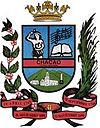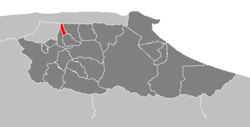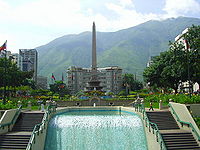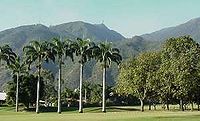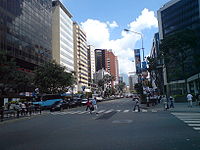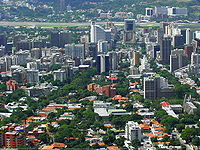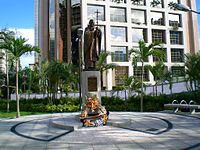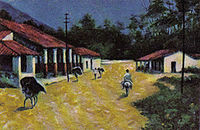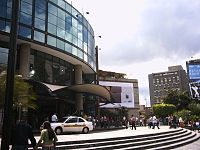- Chacao Municipality, Miranda
-
Coordinates: 10°29′N 066°50′W / 10.483°N 66.833°W
Municipio Chacao
(Chacao Municipality)San José de Chacao Church
Flag
SealChacao in Miranda State Coordinates: 10°29′47″N 066°50′56″W / 10.49639°N 66.84889°W Country Venezuela State Miranda Seat N/A Founded September 27, 1769 Incorporated 1991 Government - Mayor Emilio Graterón Area - Total 12 km2 (4.6 sq mi) Population (2001) - Total 64,629 - Density 5,385.8/km2 (13,949.2/sq mi) Time zone VST (UTC-4:30) - Summer (DST) not observed (UTC-4:30) Website http://www.chacao.gov.ve/ Chacao Municipality, is one of the five political and administrative subdivisions of the city of Caracas, Venezuela. The other four are Baruta, El Hatillo, Libertador and Sucre. This legal entity is known as the Caracas Metropolitan District. Chacao is also one of the 21 municipalities that make up the State of Miranda, Venezuela.
Contents
Basic information
Geography
Chacao occupies the mid-eastern portion of the Caracas Valley, north of the Guaire River, bordering the other urban municipalities to the east, south and west, and the Avila National Park to the north.
Climate
The climate of Chacao municipality is classified as Intertropical because of its geographical position, its altitude of about 1,000 meters above sea level, and its annual minimum temperature of 18 °C. January and February are the coldest months with temperatures of 12 °C at night. The average high temperature is around 27 °C. The warmest months are April and May, when it can reach 34 °C.
The exception is El Ávila mountain, located over 2,100 mts., where the average annual temperature is around 15 °C, 5 °C in dry season and 25 °C at rain season.
Economy
Many of the city's shopping malls are located within the Chacao territory. The township also controls the most transited pedestrian access to the Avila National Park (Sabas Nieves), a popular destination for fitness-obsessed caraqueños. Other attractions include a restaurant district in the neighborhoods of La Castellana, Altamira and Los Palos Grandes, a Center for Performing Arts (CELARG) and the Chacao Culture Center, a public space dedicated to concerts, art expositions and other cultural activities. Parque del Este, the biggest urban park in Caracas, although largely in neighboring Sucre territory, has one of its main entrances in Chacao, making it a popular recreational and exercise area for the inhabitants of Los Palos Grandes and other Chacao neighborhoods.
The municipality has become a financial center, after many of the country's banks moved their headquarters to the formerly residential neighborhood of El Rosal, fleeing a disorganized and growingly business-hostile city downtown. The main street artery, Francisco de Miranda avenue and its vicinity, rivals Caracas' old downtown in office space availability, and is preferred by foreign companies with established offices in the country. Some signature office buildings include Parque Cristal, Letonia Center, HP Tower, Atlantic Building, La Castellana Center, Multicentro Empresarial del Este, Centro Lido, KPMG Tower, Forum Tower, Shell Tower, and other important architectural landmarks. Several other office buildings are occupied by government-controlled entities such as the Pequiven and Banco del Tesoro towers.
A dwindling traditional Venezuelan private sector has given way for new short-term businesses and franchises that bloom around the city thanks in part to soaring oil prices and in part to a lack of investor confidence in the country's long-term prospects. Chacao is again an important player in this money wave craze, with commercial and residential real estate prices among the highest in the nation. The residential neighborhood of Campo Alegre has on average the highest priced real estate in the country.
Demographics
The Cathedral and Bolivar Square area, known as Pueblo de Chacao was home to Spanish, Italian and Portuguese immigrant waves, and today represents a middle class stronghold in the municipality. Small pockets of poverty, known as barrios, are also present, some of the best known are Pajaritos and El Pedregal which are surrounded by luxury condos and opulent houses.
Law and government
The constitution of Venezuela specifies that municipal governments be divided into executive and legislative branches. The executive government of the municipality is governed by the mayor, while the legislative government is managed by the Municipal council. On March 8, 2000, the year after a new constitution was introduced in Venezuela, it was decreed in Gaceta Official N° 36,906, that the Metropolitan District of Caracas would be created, and that some of the powers of Baruta would be delegated to the Alcaldía Mayor, which would also start governing the Libertador, Sucre, El Hatillo and Chacao municipalities. Venezuelan municipalities are subdivided in parishes.[1]
Former mayor Leopoldo López Mendoza, elected in 2000 and re-elected for the 2004-2008 term, has played a prominent role in anti-Chávez politics over the past eight years. On November 23, 2008, Emilio Graterón was elected mayor with 47,54% of vote.[2] Unsurprisingly, Chacao has represented a stronghold for the Venezuelan opposition. Anti-Chavez votes have steadily represented between 85 and 95% of the total votes in the borough, throughout the length of Chavez's administration.
The Ministry of Transport and Communications has its headquarters in the Torre ITC in Chacao.[3] The Junta Investigadora de Accidentes de Aviación Civil, the Venezuelan aircraft accident investigation agency, has its headquqarters in Chacao.[4]
Mayors
- Irene Sáez (1993-1998)
- Cornelio Popesco (1998-2000)
- Leopoldo López (2000-2008)
- Emilio Graterón (2008-2012)
History
In Cumanagoto language Chakau (Chacao) means sand, the municipality was named after the Indian Cacique Chacao, who died defending his territory in 1567, the year when the city of Santiago de León de Caracas was finally established after more than three decades of unsuccessful attempts by the Spanish. The chosen location for Caracas Plaza Mayor and Cathedral was on the west side of the valley, making the fertile lands of Chacao (on the mid-east side) an ideal location for agricultural crops and establishment of haciendas. Spanish conquistador Diego de Losada, founder of the city of Caracas, included these lands in his jurisdiction.
The township of Chacao was founded by an immigration wave of the San Bernabé earthquake victims on June 11, 1641. It was officially made a Catholic parish with the foundation of San José de Chacao church.
After repeated epidemics and calamities affected Caracas, the Town Hall and the Governor and Commander in chief of the Province, Jose Solano y Bote, in 1764 thought about transferring the entire city to this location, an idea that was rejected by Caracas Bishop Mauro Tovar.
On April 15, 1769, the residents of Chacao asked for the creation of an independent ecclesiastical parish, Lieutenant Francisco Palacios y Sojo, made the request, after evaluating the economic conditions, the separation of Chacao from the Parish of La Candelaria was granted on September 27, 1769.
See also
- Miranda State
- Caracas
- Municipality
- Venezuelan Capital District
References
- ^ Tribunal Supremo de Justicia (2000-03-08). "Gaceta Oficial N° 36,906". http://www.tsj.gov.ve/gaceta/Marzo/080300/080300-36906-00.html. Retrieved 2006-07-19. (Spanish)
- ^ Consejo Nacional Electoral (2008-11-24). "Divulgación Elecciones Regionales 2008". http://www.cne.gob.ve/divulgacion_regionales_2008/index.php?e=13&m=18&p=00&c=00&t=00&ca=00&v=02. Retrieved 2008-11-25. (Spanish)
- ^ "Inicio." Ministry of Transport and Communications. Retrieved on May 6, 2011. "Torre MTC, Municipio Chacao. Distrito Capital. Tlf: (0212) 201 50 42 RIF: G-20009480-0"
- ^ "Contacto de la JIAAC." Junta Investigadora de Accidentes de Aviación Civil. Retrieved on May 6, 2011. "Dirección: Av. Francisco de Miranda, Edificio Sede Piso 20, Junta Investigadora de Accidentes de Aviación Civil, Chacao, Caracas 1010, Distrito capital – Venezuela"
External links
City-wide authority Government of the Capital District (Head: Jacqueline Faría) · Metropolitan District (Mayor: Antonio Ledezma)Municipalities Baruta (Mayor: Gerardo Blyde) · Chacao (Mayor: Emilio Graterón) · El Hatillo (Mayor: Myriam Do Nascimento) · Libertador (Mayor: Jorge Rodríguez) · Sucre (Mayor: Carlos Ocariz)Northwest Catia • 23 de Enero • Propatria • Lomas de Urdaneta • Casalta • El Atlántico • Caño Amarillo • Los Magallanes de Catia • Alta Vista • Ruperto Lugo • Lídice • Gramoven • Manicomio
Center El Silencio • Capitolio • La Hoyada • Altagracia • La Pastora • Cotiza • Quinta Crespo • Guaicaipuro • La Candelaria • San BernardinoSouthwest Artigas • Vista Alegre • Bella Vista • Colinas de Vista Alegre • La Yaguara • Zona Industrial de La Yaguara • El Algodonal • Carapa • Antímano • Washington • Las Fuentes • El Paraíso • El Pinar • La Paz • El Paraíso • Montalbán • Juan Pablo II • La Vega • Las Adjuntas • Caricuao • MameraCentereastern El Conde • Parque Central • San Agustín del Sur • San Agustín del Norte • Simón Rodríguez • Maripérez • La Colina • Las Palmas • Las Lomas • San Rafael • Los Caobos • Quebrada Honda • San Bernardino • La Campiña • La Florida • Alta Florida • Chapellín • Los Cedros • El Bosque • Chacaíto • Sabana Grande • Bello MonteSouth Cementerio • Los Carmenes • Los Castaños • Prado de Maria • La Bandera • Las Acacias • Colinas de las Acacias • Los Rosales • Valle Abajo • Los Chaguaramos • Ciudad Universitaria • Santa Mónica • Colinas de Santa Mónica • Colinas de Bello Monte • Cumbres de Curumo • El Valle • Los Jardines de El Valle • Coche • Delgado Chalbaud • La RinconadaEastern Country Club • El Pedregal • San Marino • Campo Alegre • Chacao • Bello Campo • El Rosal • El Retiro • Las Mercedes • Tamanaco • Chuao • Altamira • Los Palos Grandes • La Castellana • La Floresta • Santa Eduvigis • Sebucán • La Carlota • Santa Cecilia • Campo Claro • Los Ruices • Montecristo • Los Chorros • Los Dos Caminos • Boleíta • Los Cortijos • La California • Horizonte • El Marqués • La Urbina • Terrazas del Ávila • Lomas del Ávila • El Llanito • Macaracuay • La Guairita • Caurimare • El Cafetal • San Román • Santa Rosa • San Luis • Santa Sofía • Santa Paula • Santa Inés • Los Pomelos • Palo Verde • PetareSoutheastern Valle Arriba • Santa Fe • Los Campitos • Prados del Este • Alto Prado • Manzanares • El Peñón • Baruta • Piedra Azul • La Trinidad • La Tahona • Monterrey • Las Minas • Los Samanes • Cerro Verde • Los Naranjos • La Boyera • Alto Hatillo • El Hatillo • Los Geranios • La Lagunita • El Placer • El Guayabao • El Volcán • La Unión • SartanejasCategories:- Caracas
- Municipalities of Miranda
Wikimedia Foundation. 2010.



